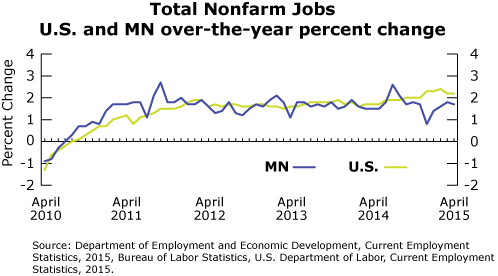by Nick Dobbins
May 2015
Monthly analysis is based on unadjusted employment data.
Employment in the Minneapolis-St. Paul MSA increased dramatically in April, adding 24,129 jobs (1.3 percent) as hiring picked up with the warmer weather. Gains were led by three supersectors in particular. Mining, Logging, and Construction added 5,976 jobs (9.8 percent), Professional and Business Services added 6,536 (2.2 percent), and Leisure and Hospitality added 6,018 (3.5 percent). Annually, the metro added 34,145 jobs (1.8 percent). Professional and Business Services had the largest numerical and proportional gains, adding 11,165 new jobs (3.8 percent). Professional, Scientific, and Technical Services added 5,518 jobs (4.5 percent), and Administrative and Support and Waste Management and Remediation Services added 6,773 (6.7 percent), but the third major component sector, Management of Companies and Enterprises, remains down (off 1,126 or 1.6 percent). Other supersectors with notable growth included Educational and Health Services (up 8,621, 2.8 percent) and Leisure and Hospitality (up 5,726, 3.4 percent). Information remains the only supersector to shrink for the year, down 219 jobs (0.6 percent).
The Duluth-Superior MSA added 1,373 jobs in April (1.0 percent) after a relatively flat month in March. Mining, Logging, and Construction added 389 jobs (4.8 percent), Trade, Transportation, and Utilities added 363 (1.4 percent), and Leisure and Hospitality added 596 (4.7 percent). Five separate supersectors contracted in April, but none lost more than 20 total jobs. Annually, Duluth added 916 jobs (0.7 percent). This is the largest proportional over-the-year growth the MSA has had since June of 2014. Trade, Transportation, and Utilities, up 938 jobs (3.8 percent) had the largest total number of jobs added thanks in large part to an increase of 621 (4.1 percent) in Retail Trade. Educational and Health Services lost the largest number of jobs, down 508 or 1.6 percent. Financial Activities, which lost 176 jobs (3.1 percent), had the largest proportional decline.
Rochester employment was up 702 jobs (0.6 percent) in April. As was common in the state, growth was led in part by a sharp increase in Mining, Logging, and Construction employment (up 359 or 9.9 percent). Trade, Transportation, and Utilities also had significant growth, adding 225 jobs (1.3 percent) with expansion in all of its component industries. Over the year, Rochester added 719 jobs (0.6 percent), with Trade, Transportation, and Utilities and Mining, Logging, and Construction once again leading the way. Other supersectors with notable annual growth included Government (up 284 or 2.3 percent on the strength of an additional 221 Local Government jobs) and Information (up 77 or 3.9 percent), which is bucking the trend of statewide job losses. The most significant job losses occurred in Professional and Business Services, which shed 188 jobs (3.2 percent) from April of 2014.
Employment in the Saint Cloud MSA expanded in April as the metro added 711 jobs (0.7 percent). While Mining, Logging, and Construction again showed the greatest proportional growth (up 134 jobs or 2.5 percent), a number of other supersectors also contributed to the strong month. Manufacturing added 205 jobs (1.4 percent), Trade, Transportation, and Utilities added 221 (1.1 percent), and Professional and Business Services added 100 (1.2 percent). Despite strong statewide growth in Leisure and Hospitality, the supersector lost 108 jobs (1.2 percent) in St. Cloud. Over the year, employment in the MSA was mostly flat, down 21 total jobs (0.0 percent). Government was down 293 jobs (1.8 percent), and Leisure and Hospitality was down 123 (1.4 percent) following its weak April, but the biggest loss came in Professional and Business Services, which was down 818 jobs (9.1 percent) and is approaching 12 consecutive months with losses of greater than 3 percent. The largest numerical job growth belonged to Educational and Health Services, which added 737 jobs (3.5 percent).
Employment in the Mankato-North Mankato MSA was down in April as the MSA shed 125 jobs (0.2 percent). It was the only MSA in Minnesota to lose employment last month, as a loss of 250 jobs (0.5 percent) among service providers trumped a gain of 125 (1.3 percent) with goods producers. Annually, Mankato added 403 jobs (0.7 percent), mostly through goods producers, who added 347 (3.6 percent).
The Fargo-Moorhead MSA added 929 jobs (0.7 percent) in April. However, it was the only MSA to lose employment in Professional and Business Services (down 168 or 1.1 percent). Annually, Fargo-Moorhead added 3,937 jobs (2.9 percent) with gains in every supersector save Manufacturing (down 134, 1.3 percent) and Professional and Business Services (down 82, 0.5 percent).
The Grand Forks-East Grand Forks MSA added 735 jobs (1.3 percent) in April, with the usual suspects, Mining, Logging, and Construction and Trade, Transportation, and Utilities, leading the way. The employment picture also remains strong over the year with the MSA supporting 1,827 (3.2 percent) more jobs than in April 2014. The only supersectors to lose employment were Government (down 172 or 1.2 percent) and Educational and Health Services (down 155 or 1.6 percent).
